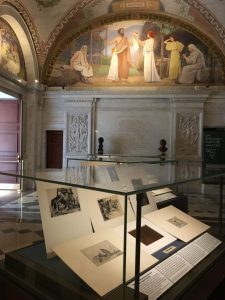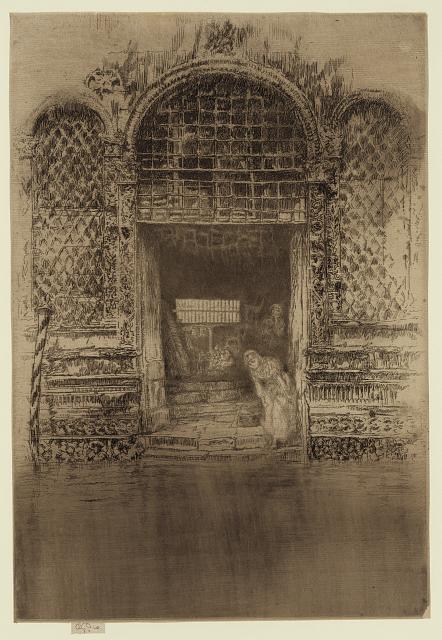This is a guest post by Katherine Blood, curator of fine prints in the Prints and Photographs Division, and Linda Stiber Morenus, a longtime paper conservator and special assistant to the director of scholarly and educational programs. The post was first published on “Picture This,” the blog of the Prints and Photographs Division.
Known for his credo “Art for Art’s Sake,” American artist James McNeill Whistler (1834–1903) was a virtuoso etcher whose delicate lines and dreamlike atmospherics were achieved through rigorous work.
“The Doorway,” etching by James McNeill Whistler, c. 1879–80
Through the end of this month, visitors to the Library of Congress can explore a special display of original Whistler etchings alongside the artist’s etching needle and one of his original copper etching plates. All come from the Library’s extensive Whistler collection, which includes over 400 etchings, lithographs and drawings, as well as photographs, technical materials, ephemera, correspondence and books. Even if you do not plan a trip to Washington, D.C., the prints featured in the display and many more are available online.
Etching is an intaglio printmaking technique that uses acid to etch lines below the surface of a metal plate. As co-curators of the display, we selected 16 etchings Whistler made throughout his career, including superb impressions from his “French Set,” “Thames Set,” “Venice Set” and “Amsterdam Set” series.

“Longshoremen,” 1859
Side-by-side comparisons printed on different papers, with variant approaches to ink application, and in different states before and after plate changes, highlight the artist’s evolving practice and careful choices to create artworks so compelling they continue to inspire artists and audiences today.
Each time the etching plate changes and is reprinted, a new “state” is produced. In the etchings below, Whistler’s earlier state of “The Pierrot” combines delicate etched lines and a thin skim of ink (or plate tone) in the foreground. The later state has extensive additions of lines that suggest deep, floating shadows. Whistler also added his butterfly monogram near the upper left corner. Though the action is set on an Amsterdam canal, Whistler has poetically imagined the young man in the role of Pierrot from the Italian commedia dell’arte.

“The Pierrot,” 1889

“The Pierrot,” 1889
Also not to be missed is an original etching by 17th-century Dutch master Rembrandt, who was one of Whistler’s early influences.

One of three “Art of Etching” display cases, with Whistler’s etching needle and an original copper plate in the center of the case. Photo by Katherine Blood.
“The Art of Etching: Masterpieces by James McNeill Whistler” is on display through September 30 in the Library’s Jefferson Building. For further explorations, the Library’s Whistler holdings are ready to study and enjoy in several of its research centers, including the Prints and Photographs Division, Manuscript Division, and Rare Book and Special Collections Division.
Learn More
- Glean some more clues about Whistler from other items digitized from the Joseph and Elizabeth Robins Pennell Collection of Whistleriana.
- Revisit earlier blog posts relating to Whistler and to Rembrandt.
- Have a look at the finding aid for the Pennell-Whistler Collection in the Manuscript Division.
- View a list of works relating to James McNeill Whistler in the Rare Book and Special Collections Division.
- Dive deep in the online catalogue raisonnė: Margaret F. MacDonald, Grischka Petri, Meg Hausberg and Joanna Meacock, “James McNeill Whistler: The Etchings, a catalogue raisonné,” University of Glasgow, 2012.

















